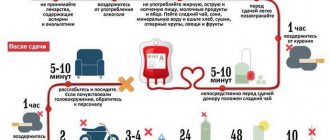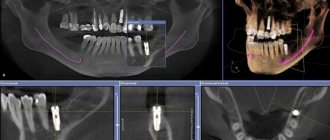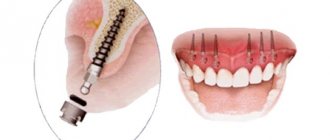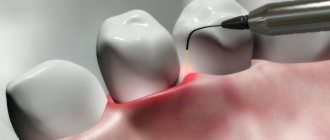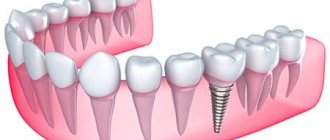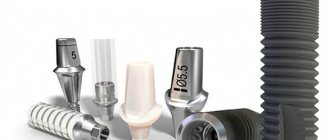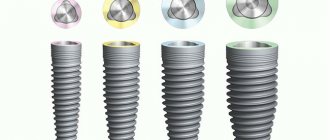X-ray diagnostics during dental implantation is required to identify diseases and contraindications. Using images, the implantologist assesses the condition of the bone tissue, and based on this, selects the appropriate method for installing implants. After the operation, X-ray diagnostics determine whether the structure is installed correctly and whether treatment adjustments are required. For a complete picture, several images are taken using different methods - a targeted image, an orthopantomogram, a computed tomography. Our clinic has its own certified radiology department.
The importance of X-ray diagnostics before implantation
The images allow you to identify obstacles to the installation of implants. They identify problems that can complicate the operation.
Using images, the implantologist determines:
- distance to the mandibular nerve and maxillary sinuses;
- density, volume of bone tissue to select the shape and size of the implant;
- the condition of adjacent teeth to prevent infection from entering the surgical area.
Lack of diagnosis can lead to:
- damage to the nerve and sinuses;
- unstable fixation of the artificial root;
- infection of the operation area;
- reducing the service life of the implant and replacing it with a new one;
- increased sensitivity of the gums due to incorrectly selected orthopedic design.
X-ray diagnostics makes it possible to exclude complications and install implants according to the correctly selected protocol in accordance with the patient’s clinical situation.
How do dental implants survive in the medium term?
Most implantation disorders occur during this period. Let us remember that the medium term is a period of up to 2 years after implantation. To the problem of implantation is also added the problem of survival of prostheses, which further confuses the overall picture. The following is clear:
- Low quality implants cause a lot of problems. Low-quality materials can oxidize or literally crumble in the mouth, leading to catastrophic consequences. Problems can be caused not only by the material, but also by the design of the implants. If the abutment and implant are poorly attached to each other, then problems will automatically arise regardless of the patient’s care for his oral cavity.
- Incorrect positioning, false advertising company. Many unscrupulous implant manufacturers make claims that may not be supported by anything. They may cite incorrect or even non-existent studies. The doctor may trust them, but the patient will suffer. No one will be punished in this case, since there is no certification for such products. A simple example - many implant manufacturers often state in their advertising campaigns that their products do not require preliminary bone tissue augmentation (if there is none). Sometimes this is really not critical, but sometimes it still matters.
- Local overload of the implant. In fact, implants are the same teeth. Therefore, they are susceptible to the common problem of overload. This problem usually occurs in people with malocclusion. Because of it, the load is not distributed evenly over the entire area of the mouth, but falls on the protruding tooth or teeth. When these teeth are not used, there is nothing to worry about. But when eating solid food, the implants become overloaded, which leads to micro-swaying of the implants. If there are too many such micro-swings, the gums begin to bleed and fester.
Neglect of care rules
The patient's careless attitude towards the work done. Implants require special care. If this care is not followed, then even the best implant will malfunction. Stupid, boorish patients may even begin to blame the doctor for their troubles. However, what can a doctor do if the client himself does not want to take care of himself?
Bad habits. Heavy smokers suffer the most. When smoke is inhaled into the lungs, it passes through the oral cavity, causing short-term oxygen starvation of the gums. This negatively affects both the gums themselves and the implants. Tobacco smoke can also cause microdamage to the blood vessels around implants, which is bad for your oral health. When asked how long it takes for implants to take root in the upper jaw so that you can smoke safely, the answer is simple - not at all. Smoking is always harmful .
Sight shot
A 2D image makes it possible to analyze the condition of 1-3 teeth. For this purpose, a digital radiovisiograph is used.
Allows you to identify inflammatory processes in neighboring teeth, monitor the condition of sealed canals, diagnose damage, and detect pathologies. It can be periapical (study of the tissues around the tooth) and interproximal (analysis of the crown).
Advantages:
- clear image of 1-3 teeth with image magnification;
- safety for the patient, several tests can be done in a row without harm to health.
Flaws:
- 2D image giving only one perspective;
- small visible range.
In our Center, the procedure is performed in a separate X-ray room. The patient is put on a protective apron, the position of the head is fixed, and the radiologist directs a beam of rays to the area being examined.
The procedure takes a few seconds, is painless, and does not cause discomfort.
Which technology for implanting lower teeth should I choose?
Choosing an implantation protocol for restoring lower jaw teeth is a task that needs to be decided together with a doctor. Only a specialist will be able to give recommendations on the implantation technology that will be optimal in your case. And he will do this based not only on an examination of your oral cavity, but also based on detailed diagnostic data. It is extremely important to remember the following: dental implantation is a serious type of surgical intervention, which must be carried out without the slightest errors and inaccuracies, which are fraught with serious and even dangerous complications. Therefore, if you are thinking about dental implantation, start by choosing a good clinic and a competent and experienced implantologist!
Our dental clinic in Moscow “Firadent” has created all the conditions for comfortable dental treatment and implantation. The clinic is equipped with modern diagnostic equipment; we use navigational implantation technology, which allows us to create surgical templates and implant implants precisely in the selected area and at the right angle. We work with the world's leading manufacturers of implantation systems, and if you are afraid of pain or simply have a strong fear of dental treatment, we are ready to offer you all procedures under sedation - medicated sleep, which is an easy and safe alternative to general anesthesia.
Getting a consultation from our clinic’s implantologists is easy and simple: make an appointment with a specialist using the contact phone numbers listed on the website.
Panoramic photograph of teeth OPTG
An orthopantomogram gives an idea of the general condition of the dental system - it shows the external and internal condition of the dentition and bone tissue. Performed on an orthopantomograph, a flat two-dimensional panoramic image is obtained - the device combines several images taken in different planes into one. Therefore, OPTG does not accurately convey the image.
The procedure defines:
- ratio of jaw, sinuses;
- location of nerves;
- hidden carious formations;
- damage to seals;
- dental diseases (cyst, periodontal pockets).
Pros:
- full picture of the jaw;
- consideration of a local problem;
- the price is lower than CT.
Minuses:
- two-dimensional images;
- likelihood of misstatement;
- does not determine the angle, thickness of the alveolar processes, structure, position of the jaw.
Before the examination, you need to remove metal jewelry and accessories. To perform OPTG, the patient bites on a special plate to keep the jaws motionless. The orthopantomograph rotates around the patient's head. The procedure lasts from 8 to 20 seconds and does not cause discomfort.
Make an appointment with an implantologist
What is the name of the doctor who makes prostheses, and who can install them?
An orthopedic dentist performs dental prosthetics, including installing crowns. However, other specialists also work with the patient before installing the prosthesis.
- The dentist-therapist carries out treatment of the tooth, mucous membranes and gums, sanitation of the oral cavity, removal of stones and plaque.
- A dental surgeon removes a root that cannot be treated. At this stage, the surgeon implants an implant into the patient’s jaw on which the prosthesis will be installed.
- Then the dental technician gets involved in the work . Based on a cast of the patient’s jaw and other information, a prosthesis is made in a dental laboratory, which is then installed by an orthopedic dentist.
An orthopedic dentist often works in conjunction with an orthodontist to correct dentition.
Computed tomography CT
CT scan is performed on a 3D tomograph. The device's detector generates two-dimensional images, which are combined into a three-dimensional 3D image in a special computer program. The method is more informative than 2D images and allows you to obtain a three-dimensional image of the jaw in high resolution.
CT diagnostics are carried out at the preparatory stage of implantation to identify contraindications and after installation of implants to prevent complications. It is applied for:
- identifying pathologies of the maxillary sinuses;
- determining the condition of bone tissue;
- assessing the location of the mandibular nerve;
- analysis of temporomandibular joints;
- detection of impacted teeth that may interfere with the installation of implants;
- diagnostics of fractures, neoplasms on the jaw.
Advantages:
- accuracy, information content;
- clarity of the picture.
Flaws:
- high price compared to other types of x-ray diagnostics.
The procedure is performed while standing, the patient bites the plate of the device and remains motionless for up to 40 seconds until the device rotates around the head.
Implants for chewing teeth - patient reviews
Patient reviews of the procedure for implanting chewing teeth are almost always positive, since today this technique allows you to be almost 100% confident in a good final result. Negative impressions are usually associated with the unprofessionalism of the doctor and an incorrectly performed implantation procedure. As for reviews of implants for chewing teeth from specific manufacturers, the leading brands include Nobel Biocare, Straumann and Astra Tech.
In any case, classical dental implantation can be performed only in the absence of serious contraindications, which include diseases of the immune system and periodontal disease, cancer and diabetes. If such restrictions exist, tooth restoration is carried out in other ways.
Before and after implantation and prosthetics of chewing teeth. Works by Kuryatnikov M.G.
Safety
According to the established SanPiN requirements, the annual exposure rate should not exceed 1000 microsieverts. Modern X-ray equipment is safe - the table below shows the radiation exposure during one image and the permissible number of procedures per year.
| Radiation exposure per 1 procedure | Safe number of procedures per year | |
| Sight shot | 1-3 µSv | 500 |
| OPTG | 13-17 µSv | 80 |
| CT | 50-60 µSv | 20 |
| Type of diagnosis | Radiation exposure per 1 procedure | Safe number of procedures per year |
| Sight shot | 1-3 µSv | 500 |
| OPTG | 13-17 µSv | 80 |
| CT | 50-60 µSv | 20 |
X-ray diagnostics are not recommended during the first and last trimester of pregnancy.
Our clinic uses a safe device that meets international standards
The digital X-ray system with a minimum level of radiation SIEMENS SIRONA GALILEOS allows you to perform the most accurate studies for patients. The device is intended for the study of bone tissue, tooth roots, temporomandibular joint, nasopharynx, and upper spine. An analysis of local problems and the condition of a large volume of jaw tissue is carried out.
Levin Dmitry Valerievich
Chief physician, Ph.D.
Price
Diagnostics in our Center is included in the cost of implantation consultation:
- drawing up a treatment plan, CT scan with examination on a computer screen without decoding and recording on DVD - 3000 rubles. ;
- drawing up a treatment plan, CT scan with interpretation, recording on DVD - 5200 rubles.
When installing implants in our Center, consultation and x-ray examination are included in the package, diagnostics after surgery is carried out free of charge. Funds spent before the start of treatment are credited to the patient’s account in the form of an advance.
You can view pricing at our clinic here.
Preparing for the examination
The procedure does not require any specific preparation; it can be carried out directly on the day of contacting the dentist or diagnostic center. However, before sending a person for OPTG, the specialist is obliged to conduct a visual examination of the oral cavity and collect a complete anamnesis, that is, take into account all complaints and possible pathological phenomena in the maxillofacial area. After the initial diagnosis, all that remains is to settle some formalities: the doctor will ask you to sign a consent to conduct the examination.
